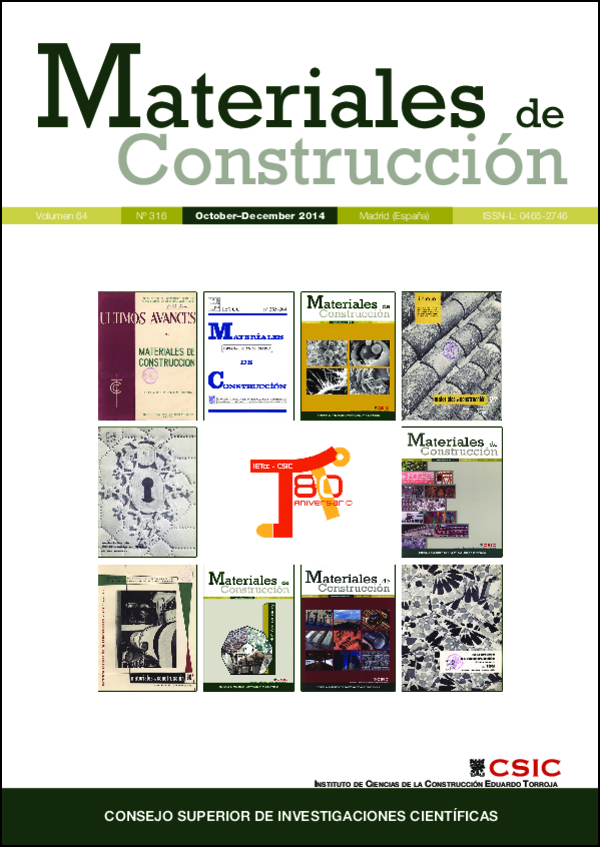Effects of mechanical cleaning by manual brushing and abrasive blasting on lime render coatings on Architectural Heritage
DOI:
https://doi.org/10.3989/mc.2014.08313Keywords:
Cleaning, Manual brushing, Abrasive blasting, Lime render coating, Image analysisAbstract
This research studies the effects of mechanical cleaning by brushing and by abrasive blasting on the lime render coating of a façade. After analysing the properties of the material, the deposits to be removed and their possible influence on the treatment, different cleaning tests were made by manual brushing and by blasting with three varieties of abrasives at 45° and 75° angles, keeping the other parameters constant. Taking the restorer’s perspective as a starting point, and in order to fulfil the practical requirements of an intervention, tests were evaluated with macro-photography, USB digital microscope and stereomicroscope with 3D visualization and measurement. From the results can be concluded that abrasives with low friability and greater grain size than the space between mortar aggregates blasted at a 75° angle reduce the differential erosion compared to other abrasives; although manual brushing has less impact on the surface.
Downloads
References
1. Iglesias Campos, M. (2010) Métodos mecánicos para la limpieza de materiales constructivos: proyección de abrasivos a baja presión. In Gisbert Aguilar, J. (ed.). La tecnología láser y otros métodos de limpieza y restauración de materiales pétreos. Documentos para la caracterización y restauración del patrimonio histórico. Cuadernos Arbotante [1], Libros Pórtico, Zaragoza, 29–43.
2. Lazzarini, L.; Laurenzi Tabasso, M. (1986) Il restauro della pietra, 318, CEDAM, Padova.
3. Ashurst, N. (1994) Cleaning historic buildings. Vol. 2: Cleaning materials and processes, 258, Donhead Publishing, London.
4. Esbert, R.M.; Ordaz, J.; Alonso, F.J.; Montoto, M. (1997) Manual de diagnosis y tratamiento de materiales pétreos y cerámicos. Manuals de Diagnosi, [5], 139, Barcelona, Col·legi d'Aparelladors i Arquitectes Tècnics de Barcelona.
5. Vergès-Belmin, V.; Bromblet, P. (2000), Le nettoyage de la pierre. Monumental. Revue scientifique et technique des Monuments Historiques, 246–248.
6. Commissione Normal. (1986) CNR-ICR. Normal 20/85. Interventi conservativi: progettazzione, esecuzione e valutazione preventiva.
7. BS 8221-1:2000. (2000) Code of practice for cleaning and surface repair of buildings. Part 1: Cleaning of natural stones, brick, terracotta and concrete.
8. ASTM International: E1857-97 (2004). Standard guide for selection of cleaning techniques for masonry, concrete and stucco surfaces.
9. AENOR: UNE 41806-3:2009 IN. (2009) Conservación de edificios. Limpieza de elementos constructivos. Parte 3: Técnicas de limpieza mecánica
10. AA.VV. (1992) Cleaning. Science for conservators. 2, 136, Routledge, London.
11. Iglesias, M.; Gea, B.; Prada, J.L.; Guasch, N. (2006) Low-pressure abrasive cleaning of historic building materials. In Fort, R.; Álvarez de Buergo, M.; Gómez Heras, M. & Vazquez-Calvo, C. (eds.). Proceedings of the International Heritage, Weathering and Conservation Conference (HWC-2006), 21–24 June 2006, Madrid, Spain,Taylor & Francis, London, 681–686.
12. Alonso, F.J.; Esbert, R.M.; Ordaz, J.; Valdeón, L.; Rojo, A.; Mateos, F. (2007) El claustro de la catedral de Oviedo: conservación de la piedra. In Restauradores sin Fronteras e Instituto de Geología Económica (CSIC-UCM) (ed.). Ciencia y tecnología para una conservación sostenible del Patrimonio Pétreo, Boceto, Madrid, 13–21.
13. Iglesias, M.; Prada, J.L.; Guasch, N. (2008). Technique for cleaning Tarragona Miocene age dolomitizied silty limestone, altered by urban pollution. Mater. Construc. 58, [289–290], 247–262.
14. Perez-Monserrat, E.M.; Varas, M.J.; Fort, R.; de Buergo, M.A. (2011) Assessment of different methods for cleaning the limestone facades of the former workers Hospital of Madrid, Spain. Stud. Conserv. 56, [4], 298–313. http://dx.doi.org/10.1179/204705811X13159282692969
15. Young, M.E.; Urquhart, D.C.M.; Laing, R.A. (2003) Maintenance and repair issues for stone cleaned sandstone and granite building façades. Build. Environ. 38, [9–10], 1125–1131. http://dx.doi.org/10.1016/S0360-1323(03)00084-2
16. Grissom, C.A.; Charola, A.E.; Wachowiak, M.J. (2000) Measuring surface roughness on stone: back to basics. Stud. Conserv. 45, [2], 73–84. http://dx.doi.org/10.1179/sic.2000.45.2.73
17. Blanco Domínguez, M. (2010) Aplicación del láser y de la proyección de abrasivos en rocas ornamentales y de cantería aragonesas. Doctoral Thesis, Universidad de Zaragoza.
18. Iglesias, M. (2003) Un ensayo de limpieza de superficies delicadas por proyección de abrasivos a baja presión. AKOBE. Restauración y conservación de bienes culturales, [4], 13–16.
19. Iglesias-Campos, M.A.; García Fortes, S.; Prada Pérez, J.L. (2014) Influence of projection angle in sandblasting cleaning on detrictic stone materials in Architectural Heritage. Mater. Construc. 64 [314] e021. http://dx.doi.org/10.3989/mc.2014.02113
20. Vazquez-Calvo, C.; Alvarez de Buergo, M.; Fort, R.; Varas-Muriel, M.J. (2012) The measurement of surface roughness to determine the suitability of different methods for stone cleaning. J. Geophys. Eng. 9, S108–S117. http://dx.doi.org/10.1088/1742-2132/9/4/S108
21. Young, M.E.; Urquhart, D.C.M. (1992) Abrasive cleaning of sandstone buildings and monuments: an experimental investigation. In Webster, R.G.M. (ed.). Stone cleaning and the nature, soiling and decay mechanisms of stone. Proceedings of the International Conference held in Edinburgh, UK, 14–16 April 1992. Donhead Publishing, London, 128–140.
Published
How to Cite
Issue
Section
License
Copyright (c) 2014 Consejo Superior de Investigaciones Científicas (CSIC)

This work is licensed under a Creative Commons Attribution 4.0 International License.
© CSIC. Manuscripts published in both the printed and online versions of this Journal are the property of Consejo Superior de Investigaciones Científicas, and quoting this source is a requirement for any partial or full reproduction.All contents of this electronic edition, except where otherwise noted, are distributed under a “Creative Commons Attribution 4.0 International” (CC BY 4.0) License. You may read here the basic information and the legal text of the license. The indication of the CC BY 4.0 License must be expressly stated in this way when necessary.
Self-archiving in repositories, personal webpages or similar, of any version other than the published by the Editor, is not allowed.


















